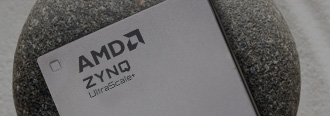- Technology
- MIPI Connectivity for Imaging

Embedded vision systems are the keystones to many advanced capabilities in modern applications, including augmented vision, automotive, machine vision, medical, and smart city cameras. Modern vision systems require high resolution, high frame rates, and increasing pixel depth, presenting significant data rate and memory bandwidth challenges. AMD offers both cost-optimized and high-performance MIPI-based solutions for camera sensor capture and display, supporting- D-PHY, C-PHY, CSI-2, and DSI protocols. Additionally, AMD offers a breadth of image signal processing IP for color conversion, correction, balancing, and other operations required by many image sensor applications. The flexibility of AMD devices helps to meet the unique requirements of every design and enables developers to meet those needs as well as differentiate their solutions.
AMD MIPI IP Cores
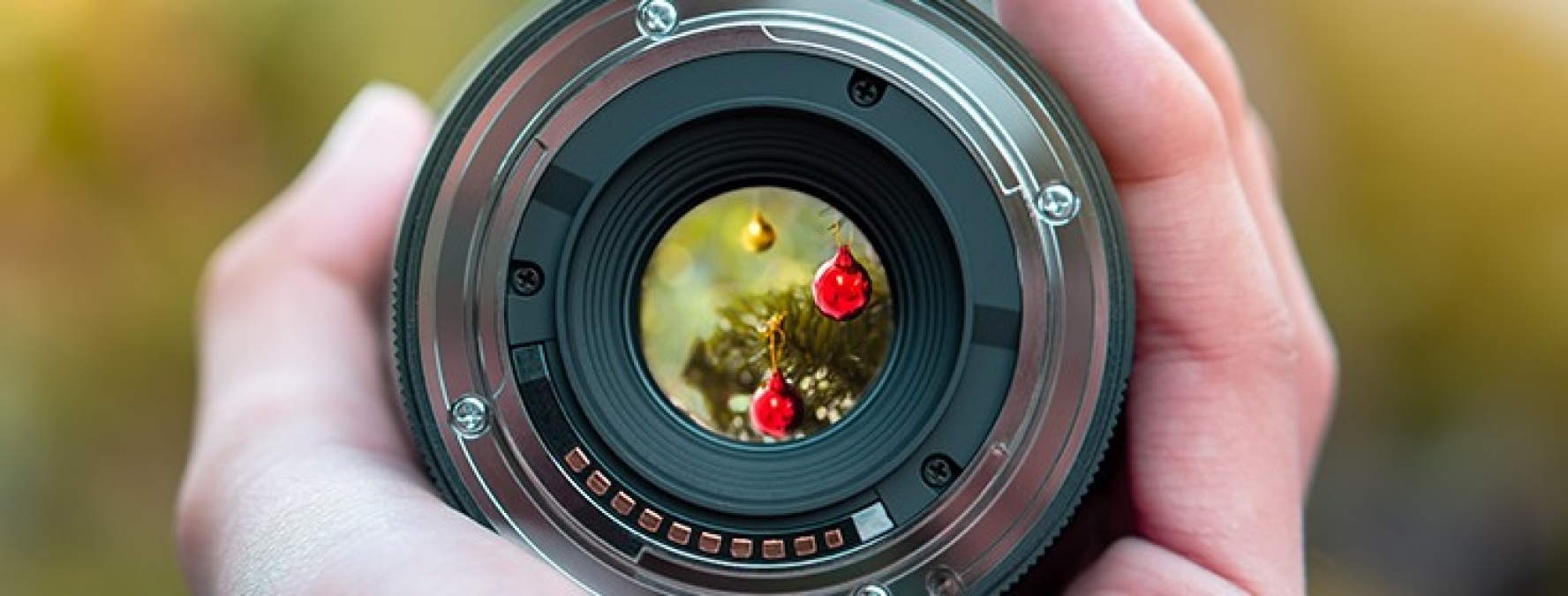
CSI-2
Receiver and Transmitter Controller Subsystems
- 1-8 lane support for RX
- 1-4 PPI lane support
- Multiple data type support (RAW, RGB, YUV)
- AXI IIC support for CCI interfaces
- Filtering based on virtual channel (VC) IDs
- Single, dual, quad pixel support output
- AXI4-compliant interface with support for 4K resolution imagers and processors
- Small resource count

DSI
Transmitter Controller Subsystem
- 1-4 lane support
- Supports for all mandatory data types
- Virtual channel (1 to 4) programmable end of transmission packet (EoTp) generation support
- Low power (LP) and ultra-low power (ULP) mode generation
- Multilane interoperability
- ECC generation for packet headers
- CRC generation for data bytes (can be optional)
- Pixel byte conversion based on data format
- AXI4-Lite interface to access more registers
- AXI4-compliant for input video streams
AMD devices support multiple MIPI configurations, from single to multiple links, different data rates, and data types, and can mix receive and transmit datapaths on a single device. AMD devices are also expandable, limited only by the number of I/Os. C-PHY will require dedicated pinouts to accommodate for three distinct voltages levels and is expandable up to three lanes. To further accelerate or streamline solutions, programmable logic enables integration of the entire image signal processing (ISP) chain while remaining scalable and field upgradable as ISP algorithms improve.
MIPI Support across AMD Products
| Cost-Optimized Portfolio | High-Performance Devices |
|---|---|
|
|
Applications
AMD offers MIPI-based solutions for camera sensor capture and display through cost-optimized and high-performance devices that enable edge-type applications across a broad set of markets
Automotive
The AMD Automotive portfolio solves industry challenges within ADAS, automated driving, in-vehicle Infotainment & driver information, and electrification & networking. Our adaptable architecture allows users to achieve low-latency compute and the ability to connect a wide array of interfaces – including MIPI. As enhancements to the MIPI protocol are released in the toolchain, flexible silicon from AMD can adapt – letting users design their systems with the latest interfaces for the fastest data transmission possible. AMD is introducing C-PHY support for reduced I/O count and higher bandwidth MIPI applications.


Industrial
Smart cities and smart retail require a complex mix of compute requirements spanning from the cloud to the edge. AMD industrial vision solutions deliver camera and image processing platforms with optimal performance, power, and cost while also offering low latency and high reliability. AMD offerings include heterogeneous embedded processing, I/O flexibility, hardware-based deterministic control, and comprehensive solutions able to handle harsh environments over industrial life cycles. The Vitis™ unified software platform and Vitis AI development environment simplify development of accelerated applications and AI inference across AMD hardware platforms, enabling video security equipment manufacturers and AI developers to rapidly create scalable and differentiated products.
Consumer Electronics
Consumer products implement machine learning to improve autonomy, user interaction, and situational awareness. Traditional applications such as DSLR cameras, printers, and video conferencing are now being accompanied by camera-enabled robots and drones, TVs, virtual reality headsets, and smart appliances. AMD offers high-resolution MIPI interfaces along with machine learning, video compression, and a wide variety of AV interfaces to achieve adaptable, low-cost, single-chip solutions. This high level of integration is enabling the next wave of immersive consumer video and imaging products with increasing levels of autonomy and analytics.


Aerospace & Defense
With 30+ continuous years of heritage and support, AMD delivers the broadest product portfolio for enabling the next generation of advancements in ground-based, airborne, and space systems. Commercial-grade and defense-grade variants of Zynq™ UltraScale+™ MPSoC devices satisfy requirements for MIPI sensor imaging and connectivity. Various platforms are available, including the UAV and Robotics Platform, which is built on the ZU7EV device with support for dual 4Kp60 MIPI connectivity in a software programmable platform.
Broadcast & Pro A/V
Whether the application is conferencing and collaboration, digital cinema, or traditional broadcast, MIPI allows for the integration of the latest sensor technology for broadcast and professional video capture applications. MIPI IP, combined with any-to-any media connectivity, a video codec unit (VCU), and 8K-capable video processing elements, enable the latest developments in applications such as intelligent digital signage, 4K UHD broadcast, machine learning collaboration, and high quality, low bit rate live streaming.

Evaluation Kits
AMD offers high-performance, low-power consumption MIPI-based solutions for camera sensor capture and display, supporting D-PHY, CSI-2, and DSI protocols.
Cost-Optimized Portfolio Platforms
A broad range of industrial and healthcare IoT applications can leverage MIPI support on our cost-optimized portfolio platforms. These include vision-guided robotics, security cameras, smart cities, smart retail, endoscopy, and machine vision. If you are looking to design with our Spartan™ 7 FPGA or Zynq™ 7000 SoC families, start with these kits.
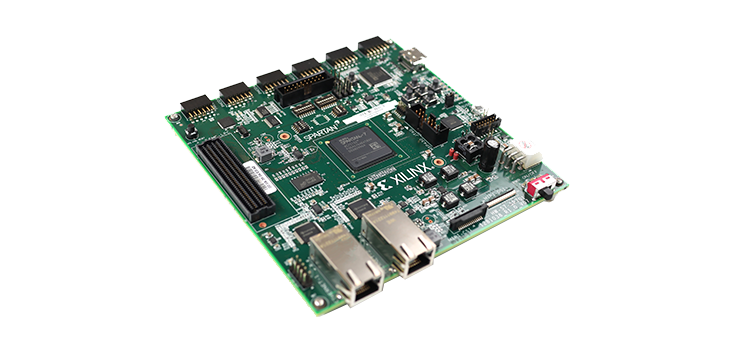
Spartan 7 SP701 Evaluation Kit
The SP701 Evaluation Kit, equipped with the best-in-class performance-per-watt Spartan 7 FPGA, is built for designs requiring sensor fusion such as industrial networking, embedded vision, and automotive applications. The SP701 features video interfaces including MIPI CSI, DSI, and HDMI. It also features high I/O availability and I/O expansion capability via Pmods and FMC connectors making it the largest IP development canvas for Spartan 7 FPGA users.
Learn more >
Featuring the Spartan 7 XC7S100 FPGA
| System Logic Cells (K) | 102 |
|---|---|
| Memory | 1,100Kb DRAM, 4,320Kb Block RAM |
| DSP Slices | 160 |
| Maximum I/O Pins | 400 |
| Additional Features | 8 clock management tiles (1 MMCM + 1 PLL) |
| 1 analog to digital converter (XADC) | |
| 1 configuration AES / HMC block |
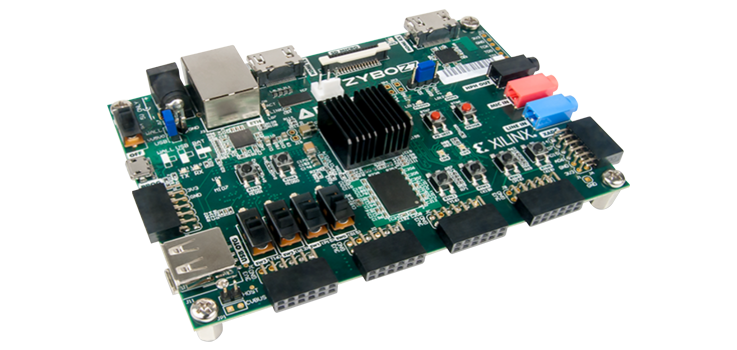
Zybo Z7: Zynq 7000 ARM/FPGA SoC Development Kit
The Zybo Z7 from Digilent is built around the Zynq 7000 device, integrating dual Arm® Cortex®-A9 processors with 7 series programmable logic. The Zybo Z7 kit offers a video-capable feature set that includes a MIPI CSI-2 compatible Pcam connector, HDMI input and output, high DDR3L bandwidth, and other multimedia and connectivity peripherals. This feature set provides an affordable solution for complex embedded vision applications.
Featuring the Zynq 7000 XCZ7010 SoC or XC7Z020 SoC
| Device | XCZ7010 | XC7Z7020 |
|---|---|---|
| System Logic Cells (K) | 28 | 85 |
| Memory | 1,024 MB DRAM 2.1 Mb block RAM |
1,024 MB DRAM 4.9 Mb block RAM |
| DSP Slices | 80 | 220 |
| Maximum I/O Pins | 100 | 125 |
| Additional Features | 2 clock management tiles (1 MMCM + 1 PLL) | 4 clock management tiles (1 MMCM+1PLL) |
| 1 analog to digital converter (XADC) | 1 analog to digital converter (XADC) | |
| 1 AES and SHA block | 1 AES and SHA block |
High-Performance Device Platforms
For AI or video-focused industrial, medical imaging, endoscopy, healthcare edge AI and more, our high-performance device platforms open up added performance and features. If your application includes a need for video encoding or machine learning, check out our high-performance line based on the Zynq UltraScale+™ MPSoCs and Versal™ adaptive SoCs.
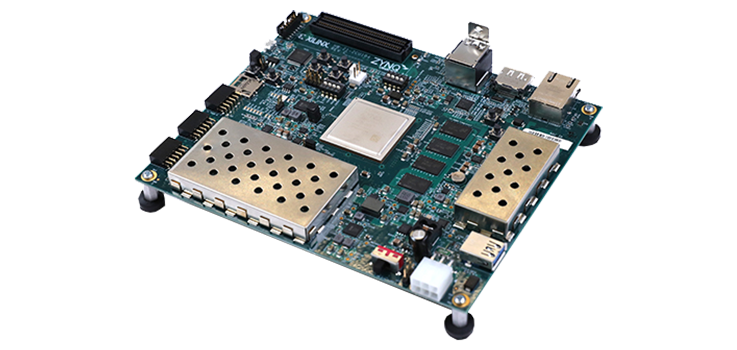
Zynq UltraScale+ MPSoC ZCU104 Evaluation Kit
The ZCU104 Evaluation Kit enables designers to jumpstart designs for embedded vision applications such as surveillance, advanced driver assisted systems (ADAS), machine vision, augmented reality (AR), drones, and medical imaging. This kit features a Zynq UltraScale+ MPSoC EV device with integrated video codec and supports many common peripherals and interfaces for embedded vision applications. The included ZU7EV device is equipped with a quad-core Arm Cortex-A53 processor, dual-core Cortex-R5F real-time processor, Mali™-400 MP2 graphic processing unit, 4 Kp60-capable H.264/H.265 video codec, and 16nm FinFET+ programmable logic.
Learn More >
Featuring the Zynq UltraScale+ XCZU7EV-2FFVC1156 MPSoC
| System Logic Cells (K) | 504 |
|---|---|
| Memory | 38 Mb |
| DSP Slices | 1,728 |
| Video Codec Unit |
1 |
| Maximum I/O Pins |
464 |
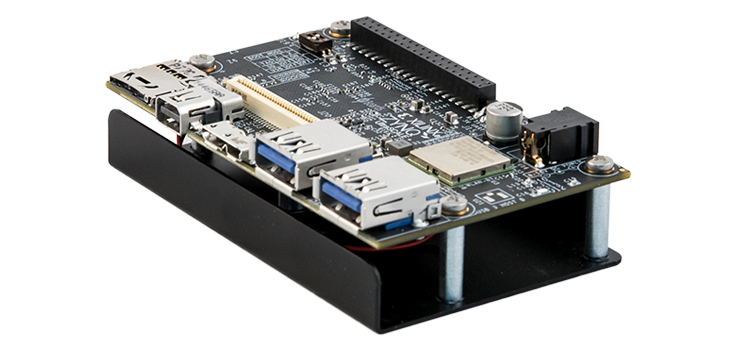
Ultra96-V2 Zynq UltraScale+ ZU3EG
The Ultra96-V2 is an Arm-based development board built around the Zynq UltraScale+ MPSoC. Available in commercial and industrial temperature grades, the Ultra96-V2 has been designed with a certified radio module from Microchip. Additional power control and monitoring is possible with the included Infineon Pmics. Engineers connect to the Ultra96-V2 through a web server using integrated wireless access point capabilities or use the provided Linux Matchbox windows environment, which can be viewed on the integrated Mini DisplayPort™ video output. Multiple application examples and onboard development options are also provided.
Learn More >
Featuring the Zynq UltraScale+ MPSoC ZU3EG A484
| System Logic Cells (K) | 154 |
|---|---|
| Memory | 7.6 Mb |
| DSP Slices | 360 |
| Video Codec Unit |
None |
| Maximum I/O Pins |
252 |
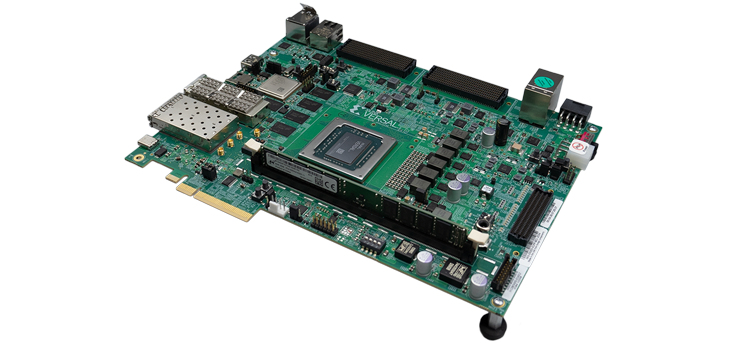
Versal AI Core Series VCK190 Evaluation Kit
The VCK190 kit is the first Versal AI Core series evaluation kit, enabling designers to develop solutions using AI and DSP engines capable of delivering over 100X greater compute performance than today's server-class CPUs.
With a breadth of connectivity options and standardized development flows, the VCK190 kit features the Versal AI Core series VC1902 device, providing the portfolio's highest AI inference and signal processing throughput.
Learn More >
Featuring the Versal VC1902 Adaptive SoC
| AI Engines | 400 |
|---|---|
| DSP Engines | 1,968 |
| System Logic Cells (K) | 1,968 |
| LUTs | 899,840 |
| Application Processing Unit | Dual-core Arm Cortex-A72 |
| Real-Time Processing Unit | Dual-core Arm Cortex-R5F |
| Maximum I/O Pins | 770 |
| Programmable NoC Ports | 28 |
| Integrated Memory Controllers | 4 |
Targeted Platform
AMD also offers a platform designed specifically to meet the extreme vision and sensor processing requirements of unmanned aerial vehicle (UAV) and robotics development.

Autonomous Control & Robotics
The UAV and Robotics Platform (URP) meets the typical processing requirements encountered when designing UAV and robotics applications. It is a Zynq UltraScale+ MPSoC-based platform, providing a broad spectrum of processing capabilities. The small form factor board integrates sensors-on-board sensors, software, and FPGA logic. With its motor control units, position sensors, obstacle detection interfaces, and communication resources, the URP can be used for many applications.
Key Features and Benefits
- Fully integrated high-performance navigation sensors
- Multi-camera and sensor fusion
- High-bandwidth connectivity
- Onboard hosting of autopilot on real-time processing cores
- Reliable high-speed motor control solution
- High-performance infrastructure for video processing
- High-level synthesis supports for rapid algorithm development and implementation
- H.265 codec VCU supporting 4K60fps
- Dimensions: 135 mm x 68.4 mm x 10 mm
- Onboard high-efficiency power supplies
- Support for NVMe SSD, PCIe®, Gigabit Ethernet, DisplayPort, HDMI
- Advanced debug support
- Industrial temperature (-40°C to +85°C)
What’s Included
- Dual 4K camera interfaces
- High-performance DDR4 memory 64bits + 8bits ECC
- Navigation sensors
- Positional sensors
- Quad motion control interfaces
- Support for NVMe SSD, PCIe, Ethernet, DisplayPort, HDMI
| System Logic Cells (K) | 504 |
|---|---|
| Memory | 38 Kb |
| DSP Slices | 1.728 |
| Video Codec Unit | 1 |
| Maximum I/O Pins | 464 |
Documentation
Get Started
| Design Example | Description | Device Support |
|---|---|---|
 |
Spartan™ 7 FPGA SP701 Application Example This example showcases a CSI-2 Subsystem IP with a PCAM camera module (Digilent), which is a popular interface used by MIPI CSI camera modules, and a DSI Subsystem IP with a display. These are both controlled by a MicroBlaze™ soft processor and all the IP is integrated in the Vivado™ Design Suite. The D-PHY is implemented on the SP701 Evaluation Kit using passive components. |
Spartan 7 FPGA |
 |
Zynq UltraScale+ MPSoC ZCU102 and Versal Adaptive SoC VCK190 Application Example This design demonstrates the use of the MIPI CSI-2 RX (decodes and processes video data) and MIPI DSI TX subsystems on the Zynq™ UltraScale+™ ZCU102 board or Versal™ adaptive SoC VCK190 board. The system receives images captured by the IMX274 image sensor. Processed images are then displayed on either an HDMI monitor or a MIPI DSI display. |
Zynq UltraScale+ MPSoC Versal adaptive SoC |
Design Tools
- Ease of use within the Vivado Design Suite and IP integrator
- Pre-built reference designs available for Spartan 7, Zynq UltraScale+, and Versal adaptive SoC devices
- Available plug-and-play IP for hardware-accelerated image signal processing (ISP) flexibility
- No previous FPGA experience necessary
- Spartan 7 FPGA SP701 Evaluation Kit Quick Start Guide
- Zynq UltraScale+ MPSoC ZCU102 Evaluation Kit Quick Start Guide
- Vivado Design Suite User Guide: Getting Started (UG910)
- Cost-Optimized Portfolio Product Selection Guide
- Zynq UltraScale+ MPSoC Product Selection Guide
- UltraFast Design Methodology Quick Reference Guide
- UltraFast Embedded Design Methodology Guide
- Vivado Design Flows Overview Videos
- Designing with the 7 Series FPGA Families
- Zynq SoC System Architecture
- Adaptive SoCs for System Architects
- Zynq UltraScale+ for the Hardware Designer
- Zynq UltraScale+ MPSoC: Boot and Platform Management
- Versal Adaptive SoC Training Courses
- Vivado Debug and Design Forum
- Vivado Design Suite Training Courses
- Vivado Video Tutorials


